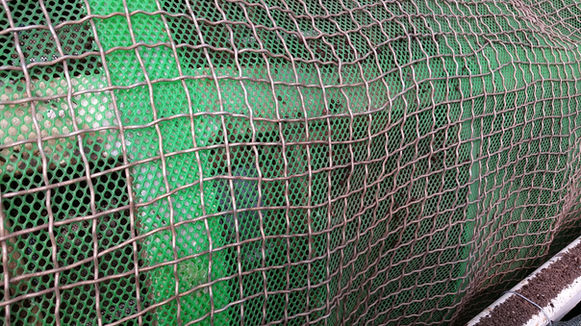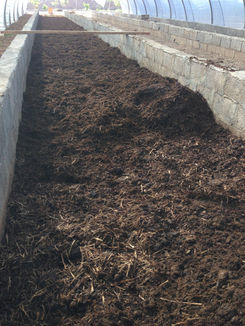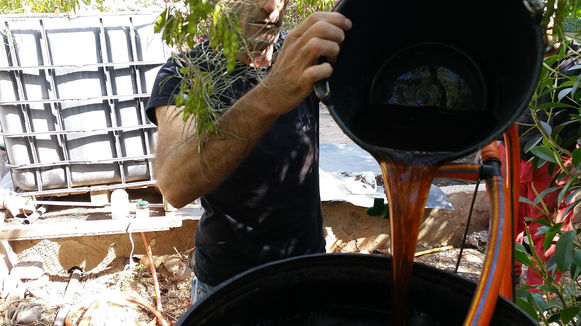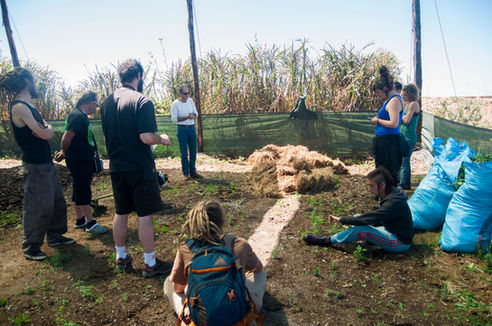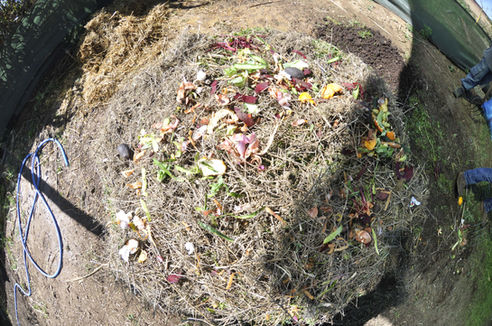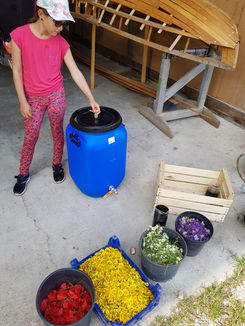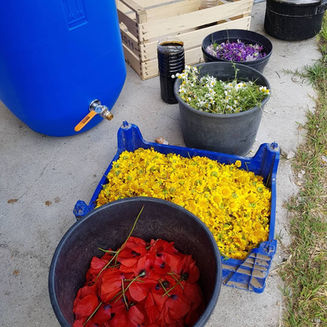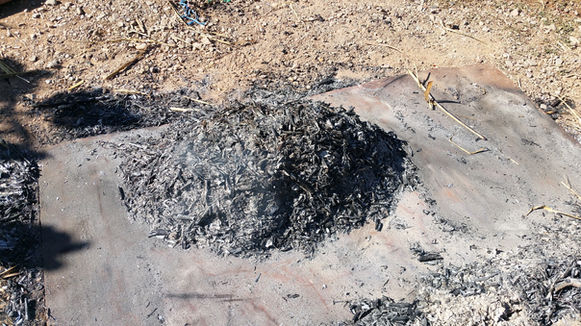
Compost, fertilité et lombriculture
THE DIFFERENT TYPES OF FERTILIZATION
AND FERMENTATION EXTRACTS
Retour d'expérience sur la mise en place d'outils pour la régénération des sols.
THERMAL COMPOSTING
In thermal compost
it is about raising the temperature of your waste pile to promote the activation of thermophilic microorganisms. These little beasts are athletes of decomposition, they transform your pile of garbage in record time. But for this to work well you have to give them air and therefore stir your compost pile very often and thoroughly. In addition, for the transformation to succeed, a good volume of waste is already needed. A pile that is less than a cubic meter will have difficulty maintaining its temperature and the activation of degradation will be slowed down.
In addition to this, you need to know more about it.
The windrow temperature should reach its maximum about a week later (between 50C ° to 65C °). When the temperature begins to drop, the compost is ready for turning. Separate large clods of material, and move the material to the side, base, and center. If the pile is too dry, now is the time to water it. Cover the battery again and wait.
In a windrow made of well-shredded material, the temperature should reach its maximum in about a week. Remember, the smaller the pieces, the faster the compost is made. As soon as the swath begins to cool, turn it over again. Another week or two passed, the compost should be finished, that is, you should have a dark, crumbly, and fresh-smelling material.
LUMBRICULTURE
Vermiculture or vermiculture consists of breeding earthworms under controlled conditions of temperature and humidity . This activity is generally associated with vermicomposting .
It is a technique that transforms and enhances organic matter , such as manure or green waste, into a high quality organic fertilizer , containing humified organic matter (and therefore not easily washable), trace elements , nutrients ( NPK ) and substances known as "Biostimulants", bioavailable and favorable to plant growth. It can be practiced on an industrial scale and it is one of the "ecological" ways of treating organic residues.
To start a worm farm, you have to start by estimating the amount of waste to be recovered in order to provide a sufficient surface area (doubling of the litter possible every 3 months depending on conditions).
The worms of the epigeal family live on the surface for the first 10 centimeters. In vermiculture it is therefore necessary to work on a surface that can receive the waste in layers of 5 cm maximum per intake and not in height as in a conventional composter. Vermiculture is aerobic cold compost.
the litter is made up of a mixture of carbonaceous matter (60 to 80%) and food with a level of humidity and ventilation conducive to the comfort of earthworms. It allows them to feed themselves, to live and to reproduce. In other words, it offers room, board and more if affinity. (Earthworms can't live on food alone)
It is necessary to respect a carbon nitrogen ratio (brown and green mixture).
OXIGENATED COMPOST TEA
Oxygenated compost tea (TCO) or Active Aeration Compost Tea (TCAA) is a liquid, organic preparation extracted and fermented from compost in the presence of oxygen. It effectively promotes the biological activity of the soil and constitutes a remarkable element for biodiversity.
Compost tea is quite simply a liquid rich in organic matter resulting from composting, which regulates the biological activity of the soil, improves its structure, particularly in terms of the aeration of the latter, and which allows an active decomposition of plant residues. thanks to the action of microorganisms. It will inoculate a high concentration of living beings in the soil, which will help boost its capacities by improving the food chains between the different organisms that live in the earth. On the other hand, it also provides important root protection, which will allow the plant to actively fight against pathogens.
- Benefits of compost tea:
Optimized plant growth
Reduction of diseases caused by different pathogens
Better absorption of nutrients by the plant
Improved life and general soil balance
Savings on the costs of amendment products
Completely biological (total harmlessness for humans and nature °
FERMENTATION EXTRACTS
The anaerobic Fermented Extract method of E.Petiot
This method is particularly interesting because the fermentation takes place without oxygen; The Fermented Extract produced anaerobically produces a fermentation similar to that of beer or wine and will give an "acid-reduced" liquid. This Fermented Extract will be much more beneficial to the plant than an aerobic "alkaline-oxidized" liquid manure. This method produces an oxidized liquid, which has entered into putrefaction. The oxidation will be less beneficial for the plant, and even attract pathogens.
Water quality, an essential point but too often neglected
We often forget how crucial water quality plays a role in the health of living organisms. Without going into details (see book E. Petiot), we must be vigilant on several criteria:
-
Rain or spring water
-
T ° to 30 ° C for fermentation to start during the day
-
The ph of the water which is between 6 and 7
Equipment :
To achieve anaerobic fermentation you will need:
-
A container hermetic to any air inlet with tap (https://www.polsinelli.it/fr/fermenteur-de-bi%C3%A8re-inox-200-l-P1140.htm)
-
A degassing plug, which can be home made or purchased
-
Wintering veil to maintain
-
Weights: stones for example
-
A dark sheet or burlap bag to keep the canister in the dark
How to use it in the garden?
-
Dilution at 2% to 10% (adult plants) foliar and 5% to 15% on the ground (T ° above 12 ° C, from April)
-
Foliar spraying: 1 to 8 times per month maximum (depending on the plant used and the problem treated)
-
Spray the soil up to 4 times per month maximum
The ingredients and the recipe:
-
1 kg of fresh nettles
-
10 l of water (see previous recommendations)
-
Conservative
EUGENIO FAT BIOFERTIZERS AND FISH HYDROLYSATE
Method for BIOFERTILANT for soil
-
The Jairo Restrepo Rivera / Eugenio Gras method biofertilizer is prepared and kept available at all times. For foliar, fertigation or watering can application.
-
It contains a lot of macro and micro nutrients, hormones, vitamins and amino acids. It is food for soil microbiology and a soluble fertilizer that can be directly assimilated by plants.
-
In a 200 l can with air lock siphon (anaerobic) https://www.polsinelli.it/fr/fermenteur-de-bi%C3%A8re-inox-200-l-P1140.htm
-
50 l of very fresh rumen (less than 2 hours after slaughter) or still lukewarm dung
-
3 kg of black molasses 500 gr of fresh yeast 3 l of fresh milk
-
5 kg of burnt bone powder and wood ash and reeds
-
3kg of granite / phosphate rock powder
-
100 l of water
-
150g Seaweed powder
Close with a metal belt and let ferment for 2/3 months. Keep the bottle full of water. Use 0.5l for 10l, or 5l for 100l of water on the ground and in leaves.
Water, sprinkle or fertilize 2/3 times during the growth cycle, or 3/4 times a year before or after the sun, in cloudy skies and after the rain
FISH HYDROLYSATE :
-
The hydrolyzate prepared in 60 l canister is permanently available. 10 kg of crushed fresh sardines
-
5 kg of black molasses
-
20 tbsp. tablespoon lactic acid (pharmacy) 30 l of non-chlorinated water
-
Beat the mashed sardines with a board in a large bowl, mix the ingredients in a container. Close with cheesecloth (or mosquito net), turn every 3 days for 3/4 weeks, filter and set aside in a cool place in full bottles with closed but not too tightly closed caps.
-
Use 10 tsp. to s in 10 l of water at the base of the roots but not on the foliar.
Rich in nitrogen, trace elements and bio-available amino acids, it contains all the elements, very good food for micro-organisms (especially fungi). Also to accelerate and enrich the compost with mushrooms and trace elements. Food for microbiology including fungis (mushrooms).
15kg of sardines are sufficient for a 60l can.
Water or fertilize on the beds prepared before sowing, at the foot of the plants 2/3 times during the growth cycle, 3/4 times a year on trees in autumn, early spring and flowering and fruiting.
BIODYNAMIC TEST
Biodynamic agriculture is a form of organic agriculture that is at the same time holistic, regenerative and positive.
It is a holistic agriculture which takes a new look at Nature: it considers the farm and more generally the Earth as a living organism. It promotes the development of more autonomous and diversified farms. It also takes into account, as far as possible, the cycles that punctuate the life of the Earth (solar and lunar cycles for example) to optimize agricultural work and the quality of products (conservation in particular). Biodynamics relies on all the intelligence of Nature to support plants and animals towards harmonious development.
Do you want to carry out this type of project?
Training is available:
Landscape reading training
Anti erosion system training
Food production training



.png)
























